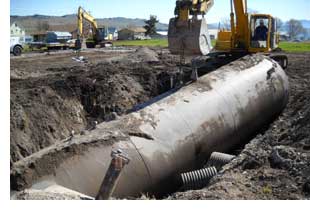Underground Storage Tanks:
 Underground
Storage Tanks (USTs) are tanks or connective piping that have at least 10% of its volume below ground. UST's are potentially harmful
because they can seep through the ground to the aquifer below, which may provide drinking water to the surrounding community. Rural
communities are especially at risk due to a large reliance on groundwater as the primary drinking water source.
Underground
Storage Tanks (USTs) are tanks or connective piping that have at least 10% of its volume below ground. UST's are potentially harmful
because they can seep through the ground to the aquifer below, which may provide drinking water to the surrounding community. Rural
communities are especially at risk due to a large reliance on groundwater as the primary drinking water source.Petroleum products are the most common types of contaminants stored in UST's. Examples of these include diesel tanks on farms and gas stations. Hazardous substances may also be stored in UST's.
The following types of tanks do not have to meet federal UST regulations:
- Farm and residential tanks of 1,100 gallons or less capacity holding motor fuel used for noncommercial purposes;
- Tanks storing heating oil used on the premises where it is stored;
- Tanks on or above the floor of underground areas, such as basements or tunnels;
- Septic tanks and systems for collecting storm water and wastewater;
- Flow-through process tanks;
- Tanks of 110 gallons or less capacity; and
- Emergency spill and overfill tanks.
Leaking underground storage tanks (LUST) are very common.
Contaminants of Concern:
Contaminants of concern are based on the type of substance, usually a liquid, being stored in the UST. Petroleum products (motor fuels, diesel) consist of the majority of UST's, however any number of hazardous substances may also be stored in UST's. Common contaminants of concern for petroleum substances include:- BTEX (crude oils high in BTEX: benzene, toluene, ethyl benzene, and xylene)
- Ethyl benzene (high in gasoline)
- Methyl tert-butyl ether (MTBE) (octane booster and clean air additive for gasoline)
- lead
Implementing Solutions:
Please submit your experiences (successes/challenges) and tribal-specific documents to share on our website using the attached form.Download Form
Resources:
UST Program Tribal Directory (Contact List) [pdf]Preventing Leaks and Spills at Service Stations: A Guide for Facilities [pdf]
UST Regulations Factsheet [pdf]
Petroleum Brownfields Opportunities [pdf]
Number of Active and Closed Underground Storage Tanks on Tribal Lands [pdf]
2010 Fiscal Year Update [pdf]
Report to Congress On UST Program In Indian Country [pdf]
Timber Lake LUST Site, Community Engagement, Cheyenne River Indian Reservation [pdf]
Websites:
Underground Storage Tanks Program in Indian Country EPA's UST Office provides technical and financial support to tribal governments to prevent and cleanup petroleum releases from USTs:www.epa.gov/ust/underground-storage-tanks-usts-program-indian-country#basic
EPA Preventing and Detecting UST Releases:
www.epa.gov/ust/preventing-and-detecting-underground-storage-tank-ust-releases
EPA UST Detecting Releases:
www.epa.gov/OUST/ustsystm/leakdet.htm
Publications Related to Underground Storage Tanks in Indian Country:
www.epa.gov/ust/underground-storage-tanks-usts-program-indian-country#pubs
UST Policy and Guidance:
www.epa.gov/ust/ust-policy-and-guidance
Leaking Underground Storage Tank Technical Policy and Guidance:
www.epa.gov/ust/leaking-underground-storage-tank-technical-policy-and-guidance
Community Engagement Resources for UST:
www.epa.gov/ust/community-engagement-and-underground-storage-tank-program#resources
Idaho DEQ Storage Tank Guide:
oneplan.org/Water%5CStorageTankGuide.asp#above
ADEC Spill Prevention and Response Heating Oil Tank Guidance:
www.dec.state.ak.us/spar/perp/hho.htm
Related Pages:
Aboveground Storage TanksBrownfields
Contaminated Sites
Emergency Planning, Management, and Response
Federal Facilities
Hazardous Waste and Emergency Response Training Requirements
Oil Spill Response
RCRA
For more information, please contact:
Jennifer Williams, Alaska Program Coordinator, Sr.
Tel: 928/523-0673
Email: Jennifer.Williams@nau.edu
Tel: 928/523-0673
Email: Jennifer.Williams@nau.edu
Last updated: July 10, 2015
